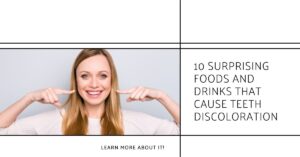If you have teeth, you know they are more than just a pretty accessory. They’re the foundation for your smile and your ability to speak clearly. The good news is that there are many ways to keep your teeth healthy – from brushing twice a day with fluoride toothpaste to drinking water with fluoride added, and even cutting down on sugary foods and drinks. In this guide, we’ll cover how you can take care of your pearly whites!
Cut Down On Sugary Foods And Drinks
Sugar is bad for your teeth, and it’s easy to find in many different types of food and drink. Sugary foods include chocolate, cakes, cookies and biscuits (and other desserts), chewing gums like Juicy Fruit or Orbit, candies such as lollipops or hard candy, soft drinks such as cola/soda/energy drinks, etc., sweetened tea/coffee (no milk please!), energy bars… the list goes on! Try not to eat these things every day though because they’re too much sugar for a person who doesn’t have any extra cash at the moment!
The recommended amount of sugar you should eat each day is 25 grams which equal about half a cupful of sugar per day – just keep an eye out so that this doesn’t happen too often!
Make Sure You Clean Between Your Teeth Daily
You might be tempted to skip cleaning between your teeth because it’s not an everyday occurrence. But daily oral hygiene is critical for keeping your gums healthy and preventing gum disease, which can lead to tooth loss and other dental issues. If you’re not sure what to do, try brushing with a toothbrush and flossing—and don’t forget about the back of your throat as well!
Don’t use your teeth as a tool for picking up food or opening bottles: The last thing you want is for bacteria from raw meat or unwashed vegetables (or worse!) to get into those hard-to-reach places where they could cause serious damage. Instead of reaching for the bottle opener with one hand while holding onto a chicken wing with another, just use both hands instead; then turn off all electrical appliances before eating anything so that nothing sneaks up on you unexpectedly during dinner time
Visit Your Dentist Regularly
It’s important to visit your dentist regularly, not just for teeth whitening but for overall oral health. Your dentist can help you avoid gum disease, tooth decay, and other problems.
During your regular visits, your dentist will clean your teeth and check for any cavities or other problems. If you have any concerns, be sure to ask your dentist about them.
Visiting your dentist regularly is an important part of taking care of your teeth and maintaining good oral health.
Drink Tap Water
You might be surprised to learn that fluoride is a mineral that strengthens teeth by making them more resistant to decay. It’s naturally present in water, but it can also be found in toothpaste and mouthwash. Fluoride is added to some supplies of tap water as well, so you shouldn’t have to worry about not being able to get enough of this important nutrient from your daily routine.
If you’re not sure if there’s fluoride in your area yet, simply ask at any grocery store! Most will have it on their shelves ready for purchase or sale—just make sure you buy plain bottled water instead of one with additives (like flavors).
Brush Your Teeth Last Thing At Night
The best way to keep your teeth healthy is to brush them at least twice a day, one time in the morning and once before bed. Brush for 2 minutes, using a fluoride toothpaste that contains 0.5% or more fluoride. You can use an electric toothbrush or manual (paddle) one with small heads, but stick with one that has soft bristles so it’s easy on your gums and not too abrasive when you’re brushing hard surfaces like braces or crowns!
Brushing also helps remove bacteria from between teeth; this will help prevent gum disease as well as plaque buildup on the surface of your teeth. Use an antibacterial mouthwash after brushing too – make sure it contains at least 1% alcohol!
It’s essential to replace your brush every three months or sooner if it becomes splayed; otherwise, bacteria can build up on the bristles and cause gingivitis (gum disease). You may also see white or gray growths on your toothbrush as well as yellow stains on its handle if you’re using an old one with worn-out bristles—these are signs of plaque buildup on the brush head!
If You Are Seven Or Over, Use Fluoride Mouthwash Daily After Brushing
If you are aged seven or over, use a fluoride mouthwash daily after brushing. It can be used as an alternative to fluoride toothpaste and will help prevent tooth decay by strengthening the enamel on your teeth. Fluoride is found in water and toothpaste, but it’s also present in some foods such as fruit juice or tea leaves.
Mouthwashes with at least 0.05% fluoride content have been shown to prevent dental caries (tooth decay) by bonding with a bacterial plaque that forms on teeth when they are exposed to sugars during eating or drinking something sugary like sweets or carbonated drinks
Stop Smoking To Prevent Staining And Gum Disease
Smoking can cause yellow teeth and gum disease, which is why you should stop smoking. If you have a lot of yellow stains on your teeth, it’s because of the nicotine in cigarettes. That’s why we recommend that anyone who smokes should switch to e-cigarettes or other non-tobacco products as soon as possible.
It also has been shown that people who smoke more often than once every week are at higher risk for gum disease compared with non-smokers, according to the American Dental Association (ADA). The ADA recommends quitting smoking completely if possible—but even if you’re able to quit cold turkey, quitting will help protect your teeth from further damage caused by tobacco products.*
Conclusion
We have covered it all here, so now you are well prepared to keep your teeth healthy and sparkling. Remember that dental health is a long-term commitment and isn’t something you can just switch off after a few weeks of bad habits. If you follow our tips then we are sure that your teeth will stay white, bright, and clean for years to come!




